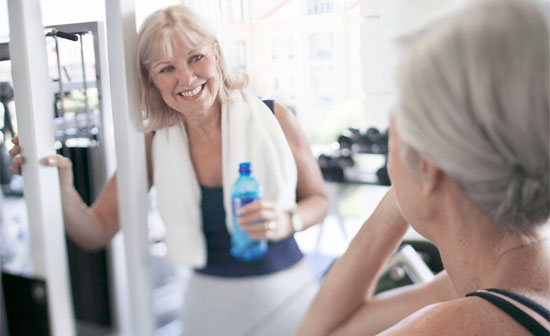- Don’t rely on thirst as an indicator of your body’s need for fluids. By the time you’re thirsty, you’re already dehydrated! If your urine is dark and there’s not much of it, you’re dehydrated and should increase your fluid intake.
- Drink fluids until your urine is pale yellow/clear and plentiful.
- In general, drink as much fluid as you can comfortably tolerate both before, during and after exercise. Drinking small amounts frequently usually works better than drinking a large amount once or twice.
- General guidelines for fluid intake are: 2-3 cups about 2 hours before exercise ; 1 cup 5-10 minutes before exercise ; 1 cup every 15-20 minutes during exercise, especially in warm weather
- Cool beverages are absorbed better than warm beverages.
- Studies have shown that the stomach can only empty about 1 quart of fluid/hour during exercise. More and you could feel bloated.
- You’ll often see athletes pouring cold water over their head during a race or competition. While this may provide some temporary relief, pouring enough cold fluid into the body is more effective in dealing with hot temperatures.
What about sports drinks?
It’s a good idea to drink a beverage with 4-8% carbohydrate (and electrolytes) during vigorous physical activity. This is typically half the carbohydrate concentration of soft drinks and promotes fluid absorption while providing energy. Sports drinks are typically formulated to meet this criterion. While many people consider sports drinks unpalatable during rest, they appreciate these lightly sweetened/flavored beverages during sports participation. Because some athletes tolerate various beverages or sports drinks differently, never experiment during a competition. Your training workouts are the time to try new and different options.
Do I have to buy a commercially prepared sports drink?
Sports drinks are convenient beverages that have been formulated to contain an ideal mix of carbohydrate, sodium and water for sports participation. However, you can make your own inexpensive “sport drink” by using any fruit juice or fruit drink and diluting it in half with water. Remember to read labels because fructose as the primary source of sugar appears to be absorbed more slowly and may cause stomach distress in some people. Experiment to see what works for you. You can also find a sports drink recipe from Nancy Clark’s Sports Nutrition Guidebook, which simulates the nutritional content of most commercial sports drinks. Homemade beverages are definitiely easier on your budget!
Do the fluid recommendations change after I’m through exercising?
Some athletes find it helpful to weigh themselves both before and after a workout. For every pound of weight you lose during a workout, drink 2.5 – 3 cups of fluid. Rehydration occurs faster in the presence of sodium (salt), regardless of whether this sodium is provided in a sports drink or food.
To replace muscle glycogen stores and speed recovery from the workout, you should start replenishing carbohydrates within 15 minutes after exercise. You may not feel like eating so soon after a workout, but a sweetened beverage will often hit the spot. You’ll get more carbohydrate per ounce of fluid if you choose fruit juice, a juice drink or other “typical beverage” instead of a sports drink.
What about heat cramps?
Heat cramps are brief, often excruciating muscle contractions which can occur in athletes who sweat a lot, particularly when exercising in a hot environment. Usually this happens because the person has a lost large amount of sodium chloride through sweating and hasn’t consumed sufficient sodium when replacing fluid losses. Mild heat cramps can be treated by drinking 1 liter (about 1 quart) of water with about 1/4 to 1/2 teaspoon salt dissolved in it. Athletes with normal or low blood pressure shouldn’t restrict their sodium intake. Salt tablets should definitely be avoided because they are a gastric irritant.
Heat acclimatization appears to reduce the incidence of heat cramps. Heat cramps can often be prevented by following the above suggestions for fluid intake, having adequate sodium in your diet and gradually progressing your training.

